No products in the cart.
November 5, 2025
The world is currently moving in a direction that frightens me. In the United States, critical voices are being silenced. Foreign journalists who report neutrally are having their accreditations revoked.
In Germany and Europe, too, people who call a spade a spade within the democratic spectrum are experiencing hostility and even shitstorms that go so far as to become a form of violence themselves – and hardly anyone is standing up to protect them. The rules of democracy and freedom of expression are being shifted bit by bit. For many marginalised people, this is no longer just about words, but about their right to live in safety.
This approach follows exactly the playbook of right-wing populist, authoritarian or autocratic governments. That's how they start! They restrict the rights and freedoms of women and marginalised groups, and censor the press and the arts.
Because whoever controls art and media determines which stories are told: about the past, present and future. Narratives shape identity and collective memory. When criticism disappears, all that remains is the image that those in power create of themselves.
But art can never be completely eradicated. It can be suppressed, censored, exploited or forced underground, but it will never disappear.
Even during the Nazi regime, art continued to exist in secret despite massive attempts at conformity. Artists such as Felix Nussbaum painted in hiding. Despite the danger to his life, he documented his reality without conforming or allowing himself to be silenced. Many of his works depict fear, persecution, isolation and the impending end.
In Eastern Europe (from the Soviet Union to Poland, Czechoslovakia, Hungary and the GDR), official art after the war was primarily propaganda, but an unofficial scene flourished in parallel. In samizdat culture, political writings, essays critical of the regime, banned literature (e.g. Pasternak's Doctor Zhivago, Mandelstam's poems, Solzhenitsyn's works), but also Western literature, philosophy, religious texts and even song lyrics were secretly reproduced and passed on under the table.
Under military dictatorships in Latin America (Chile, Argentina), resistance art emerged, ranging from songs such as ‘El pueblo unido’ to murals painted at night. Many of these works became symbols of resistance and have survived to this day.
Even in North Korea, where state control is extreme, there are cracks. In private, caricatures and poems are created that are never allowed to be shown publicly. Refugees report secret satire, songs sung in secret, diaries documenting life in the shadows. Some who managed to escape, such as the painter Song Byeok, now process their experiences in open, critical art.
There is and never has been a regime so powerful that it could completely eradicate art. Even when paintings and book were burned, artists murdered and voices silenced, art remained.
Not all crises are political. Even during plague epidemics, famines and natural disasters, people painted, wrote and sang. Often because there was simply no other outlet. Art is – among other things – expression. And expression always finds a way.
Art does not arise in a vacuum. It responds to social, political, religious and cultural developments. The end of the Byzantine Empire, for example, was not only a turning point between the Middle Ages and the early modern period.
After the conquest of Constantinople in 1453, many scholars fled to Italy, bringing ancient writings with them. Their arrival sparked a new enthusiasm for ancient knowledge. This had been forgotten in Europe for centuries, fragmented and, when available, mostly subordinated to theological purposes. Renaissance humanism brought this knowledge back to the centre of thought and linked it to a new, optimistic view of humanity.
The changed view of humans as self-determined individuals also gave artists a new role. Painters and sculptors were no longer mere craftsmen working on commissions, but intellectuals engaged in philosophy and science. They put their experiences and thoughts into their work and commented on their times.
And so it has been ever since.
But art is not only a mirror, it is also a tool that shapes our times.
It is a multiplier of thoughts. Art captures ideas in images, often making them understandable in the first place. Art puts its finger on the wound, is memorable and emotionally accessible. It has the potential to reveal what is meant to be concealed. Powerful systems know full well that paintings, literature, or theatre can be more dangerous than speeches or numbers because they appeal to emotions and thus unite resistance. This also makes art a target.
When a society enters a crisis, whether due to war, epidemic, dictatorship or climate catastrophe, the position of art in that society also changes. Art becomes more immediate, speaking more strongly of fear, grief, resistance or hope.
When resources are lacking, when materials are scarce or prohibited, new forms of expression emerge. Reduced means, improvised forms, coded messages. Crises put artists in situations where they have to become creative in order to be able to say anything at all. Styles and entire art movements can change radically as a result.
People need expression and communication to process their experiences. Art is an outlet, not only, but especially when experiences are marked by threat, uncertainty, or loss. And this in turn means that art becomes particularly powerful in times of crisis. If it is not captured and instrumentalised, it can offer comfort, but also condemnation. It can give hope or denounce injustices.
This does not mean that art automatically becomes heavier and more serious in times of crisis. There is also art that is deliberately light, playful, or humorous, precisely because the world is so bleak. Humour, irony, and lightness take the edge off fear by ridiculing it and creating a counterworld to the crisis.
Let's stay with the Renaissance for a moment. With central perspective, anatomical studies and a new view of humanity, art became more realistic and immediate. Faces gained individuality and expression, bodies had volume and presence. Because art had become so realistic and impressive, it shaped ideas: what does a human being look like, what does God look like? What is beautiful?
But the patrons remained primarily the Church, princes and wealthy merchants. And so the themes also remained religious or representative. The depictions aimed at beauty, harmony and idealisation. This is precisely what created a discrepancy.
While magnificent Madonnas, immaculate saints or elegant patron families appeared in the paintings, the majority of the population lived in poverty, insecurity and, time and again, in the shadow of plague, hunger or war. Art shows how the powerful and the Church wanted to see themselves, thereby revealing how great the gap between this and the reality of the people was.
The noticeable gap between pomp and reality awakened both an awareness of social contrasts and a longing for change.
Human beings are no longer merely sinful creatures awaiting salvation, but curious, self-determined beings who are allowed to explore the world. ‘Sapere aude – have the courage to use your own understanding’ (Kant's formulation in his famous essay ‘What is Enlightenment?’, written in the 18th century but rooted in humanism, which is still worth reading today) describes this attitude.
And so the Renaissance, the rebirth, was characterised by a spirit of optimism and new beginnings. In 1498, Vasco da Gama reached India by sea. During the 16th century, the Portuguese established trading posts in Africa, India, Southeast Asia and Brazil.
In 1492, Christopher Columbus reached America. Spain soon controlled large parts of South and Central America. England and France also began voyages to the ‘New World’ in the early 16th century (e.g. John Cabot in 1497, Jacques Cartier in 1534), to name but a few.
It is not without reason that we refer to this as the Age of Discovery. This marked the beginning of colonisation, with all its catastrophic consequences for indigenous populations. Europe and the world underwent lasting change. Access to precious metals, spices, new plants (potatoes, corn, tomatoes, tobacco) and animals transformed structures of wealth and power.
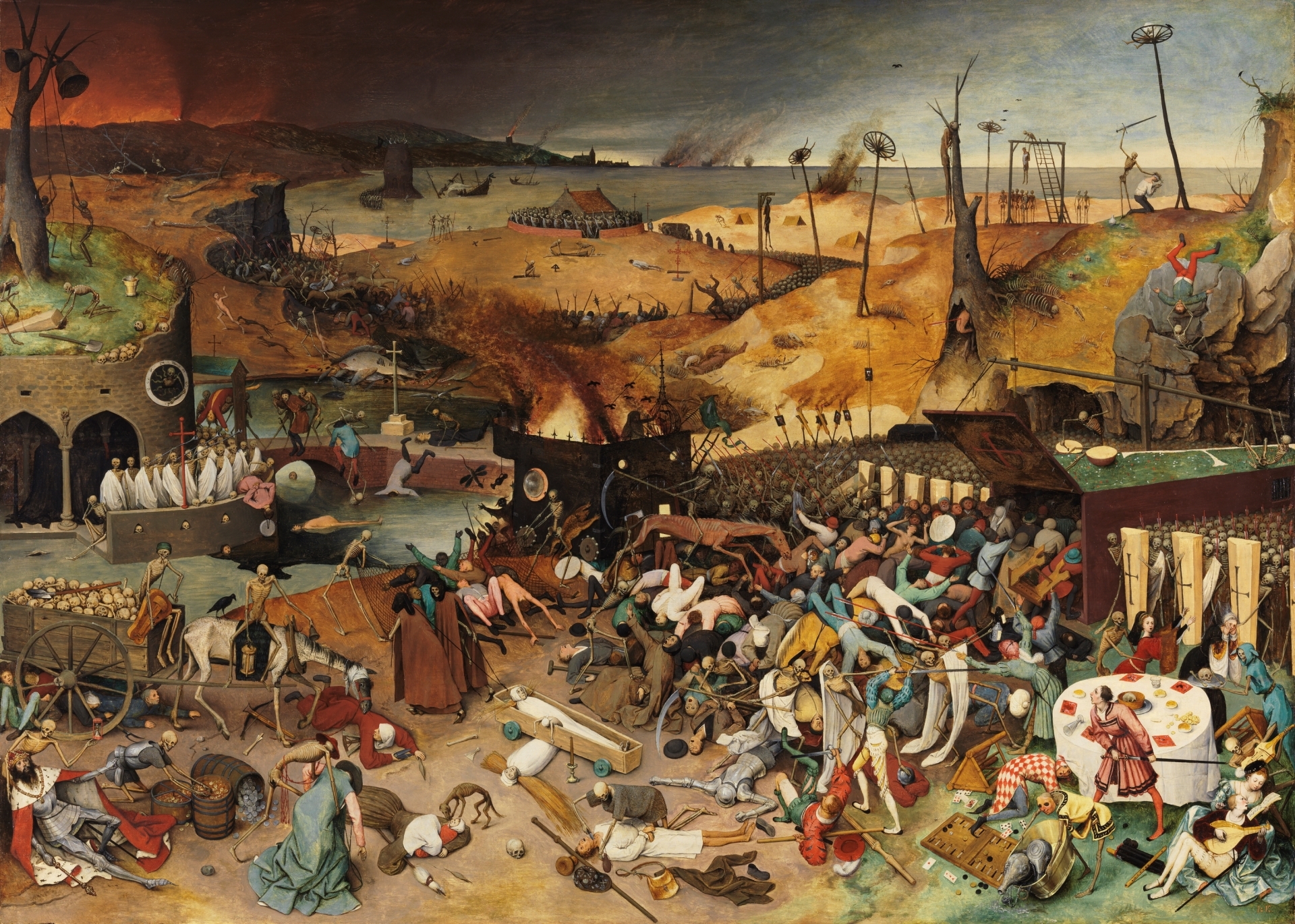
Pieter Bruegel the Elder, The Triumph of Death (1562–1563), ©Museo Nacional del Prado
People no longer accepted their circumstances as God-given; they began to question them. Humanists studied the Bible in its original languages (Greek and Hebrew), not just in the Latin Vulgate version. This return ad fontes (to the sources) revealed inconsistencies and called the Church's interpretation into question.
In 1517, Luther published his 95 theses against the sale of indulgences. This marked the start of the Reformation. Thanks to the printing press, the theses spread throughout Germany within a few weeks and, shortly afterwards, throughout Europe.
The schism in the Church was not only a matter of faith, but also a political one. Princes, cities and entire countries had to decide whether to remain Catholic or accept the new doctrine. This broke a centuries-old consensus and created a patchwork of alliances and enmities.
Europe sank into a century of religious wars. Of course, art alone was not the trigger for this, but it did contribute to it. For better and for worse.
The Church took advantage of this in the 17th century. At the Council of Trent (1545–1563), it decided to use art as a means of strengthening faith and obedience. This marked the beginning of the Baroque art period and the emergence of overwhelming, dramatic imagery designed to strike an emotional chord with the faithful. Paintings became more monumental, full of movement and contrasts.
The Thirty Years' War raged and devastated large parts of Europe. The experience of death and destruction is reflected in art through an abundance of vanitas depictions. Skulls, extinguished candles, wilting flowers, precious objects alongside symbols of decay.
In a time of existential uncertainty, the Church used art as propaganda to regain its power. While the symbols of vanitas omnipresently depicted both death and the emptiness of all earthly things, religious splendour painted the past as beautiful and peaceful as it never was. ‘Your turning away from God is to blame for the world sinking into chaos. Come back into the bosom of the Church, be humble and stay in your place, and everything will be fine again.’
Even today, this is still a popular stylistic device of authoritarians (‘great again’). Progress is bad, and as long as the rich get richer and the powerful get more powerful, you don't have to be better off: it's enough if others are worse off.
And when nothing else helps, God will surely help. Just believe in it firmly.
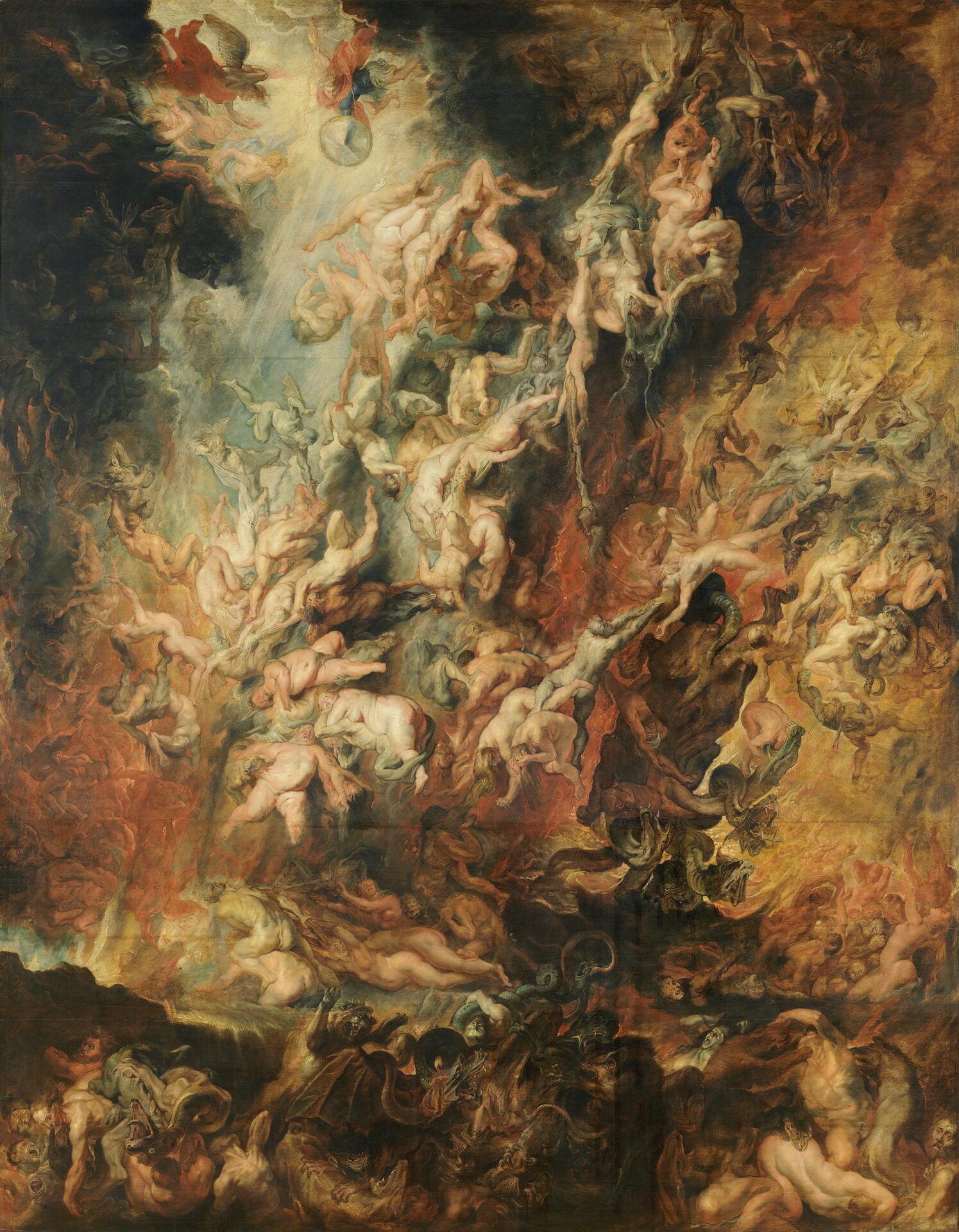
Peter Paul Rubens, The Fall of the Damned into Hell, Alte Pinakothek, München
The current TikTok trend ‘Jesus glow’ works in a similar way. Faith is staged as a lifestyle transformation, made visible and shareable, emotionally effective, instantly consumable. This works because these strategies target human psychology – sensory overload, narrative coherence, iconography, and rituals create belonging and trust. In times of crisis (uncertainty, identity issues), people are particularly receptive to powerful images and simple narratives.
The Baroque period is a textbook example of how power uses images, space and ritual in a targeted way to direct emotions and shape the masses.
For a while, this was quite successful. But ultimately, the Counter-Reformation was unable to stop progress. Backward-looking movements never can. They only cause a great deal of damage along the way.
After more than a hundred years of religious and religiously framed wars (from the Peasants' Wars to the Huguenot Wars to the Thirty Years' War), Europe was bled dry. The experience that religion constantly brought war led to scepticism towards dogma and calls for tolerance.
The discoveries of Galileo Galilei, Johannes Kepler and Isaac Newton, for example, showed that the world cannot be explained by ecclesiastical authority, but by natural laws that can be explored. This encouraged people to apply reason to other areas as well, such as politics, society, and morality.
The 18th century was marked by the Enlightenment, which focused on reason, science and progress (once again Kant: ‘Enlightenment is man's emergence from his self-imposed immaturity.’). This did not protect it from crises and upheavals. In France, in America, and later throughout Europe, questions of freedom, civil rights and equality were raised.
After the end of the Thirty Years' War, mistrust of religious repression ran deep. In the 18th century, trade flourished, prosperity grew in many regions, and a middle class gained influence. This class wanted more rights, not only economically but also politically and culturally, and questioned ecclesiastical and feudal structures.
However, the new wealth was concentrated in the hands of a few. In rural areas, the majority of the population continued to live as dependent farmers. Agriculture was dependent on the weather and had undergone little modernisation. Crop failures quickly led to food shortages. Bread was the staple food – when the price of bread rose, it simply meant hunger for the masses.
Many countries had once again been embroiled in decades of war during this century (the War of the Spanish Succession, the Seven Years' War, etc.). France was particularly heavily indebted. Nevertheless, the nobility and the church clung to their old privileges. They remained largely exempt from taxes, while peasants, citizens, and merchants footed the bill.
In England and the colonies, too, trade restrictions and taxes led to anger against the Crown.
Economic hardship greatly increased the willingness to embrace radical change.
The ideas of philosophers such as Locke, Voltaire, Rousseau, and Montesquieu had enormous explosive power because they offered an alternative to the existing system. Suddenly, it was conceivable that ‘we could live differently’. The second half of the 18th century saw several revolutions. The American Revolution (1775–1783) was the first, followed later by the French Revolution (from 1789) and the Haitian Revolution (1791–1804), the first successful slave revolution.
In addition, there were movements in the Netherlands (Patriot Movement, 1780s) and attempts at reform in other countries, but these often failed or were suppressed.
At the beginning of the 18th century, art turned away from the moralising themes of the Baroque, but still made use of its opulence. Rococo was frivolous, playful, light, decorative and full of pastel colours. It was all about pleasure, eroticism and the gallant life (e.g. François Boucher, Jean-Honoré Fragonard).
In the second half of the 18th century, however, art responded with clarity to reason and with pathos to the revolution. Classicism became the visual language for a new political and moral aspiration, a conscious departure from Baroque splendour and ecclesiastical representation. Instead, it often served explicitly to mobilise political support. Jacques-Louis David, for example, made his works symbols of republican virtue, martyrdom and civic oaths. Art thus became part of the language of the revolution.
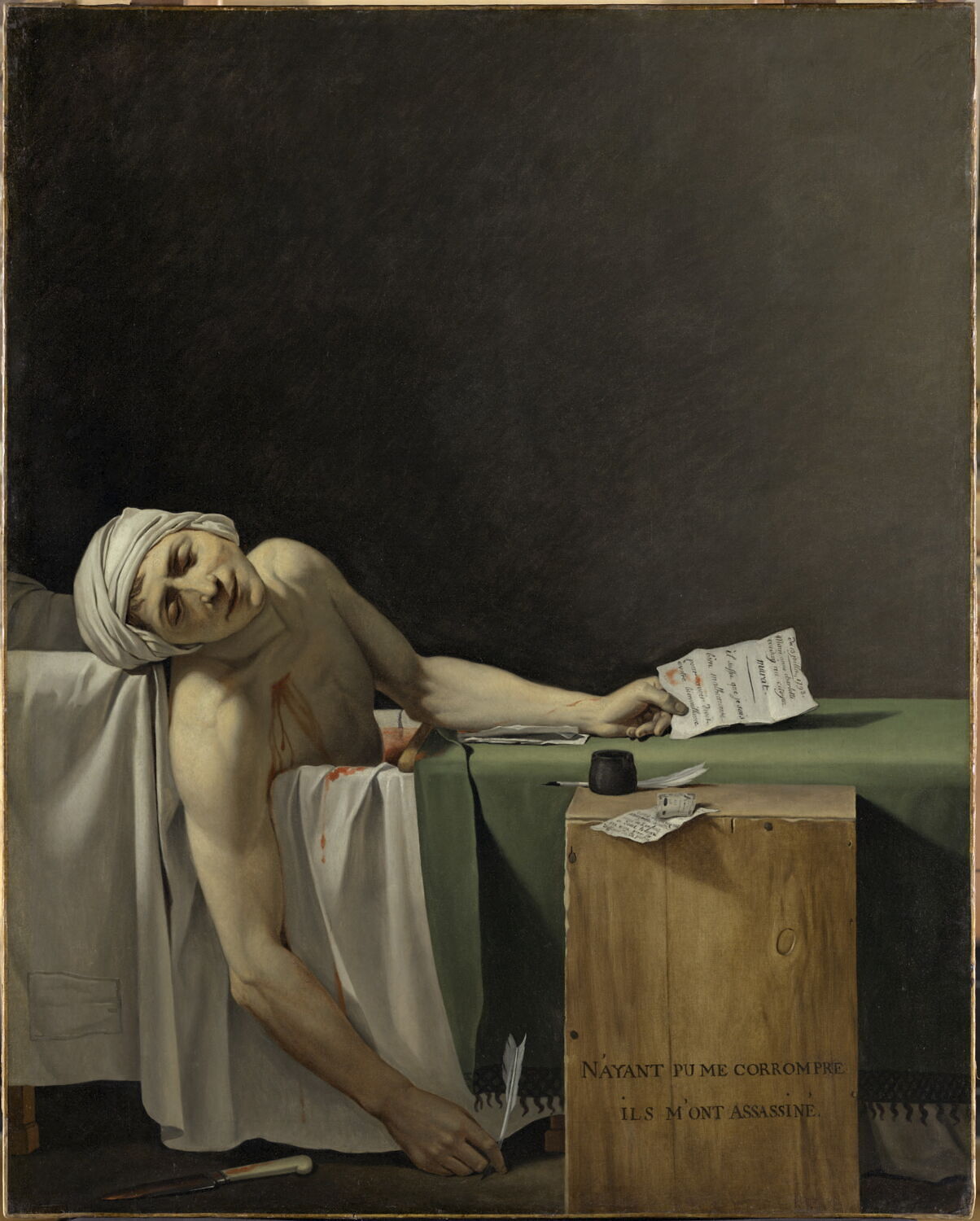
Jacques-Louis David, The Death of Marat, Musée du Louvre, Paris
The Enlightenment changed the way people thought. People no longer relied solely on traditional authorities; they sought verifiable knowledge. This gave the natural sciences a tremendous boost and paved the way for technical innovations in fields such as mechanics, chemistry and physics. Inventions such as James Watt's improved steam engine would have been inconceivable without this new understanding.
Political upheavals, above all the revolutions, had weakened the old feudal structures and made way for a society that was interested in progress and had sufficient resources to invest in new technologies. Thus, new ways of thinking, scientific discoveries, economic interests and social changes flowed into one another and led to the Industrial Revolution becoming possible in the 19th century.
And yet, the 19th century was almost entirely marked by crises, upheavals and contradictions. Politically and socially, it began with the Napoleonic Wars, which shook the whole of Europe. This was followed by the revolutions of 1830 and 1848, the great famine in Ireland, colonial expansion, national movements and, at the end of the century, the social conflicts of industrialisation.
Almost every generation experienced a new crisis.
The Irish famine from 1845 to 1852 was one of the greatest disasters of the 19th century in Europe. It was caused by potato blight, which destroyed almost all crops. For a large (the poorer) part of the Irish population, potatoes were the main staple food, not only a basic component of their diet, but often their only reliable source of nutrition. When the harvests failed year after year, it simply meant hunger and death.
Ireland was under British rule. While people were starving, food continued to be exported from Ireland, and the British government's response was hesitant and inadequate. Around one million people died of malnutrition, disease and weakened immune systems. Twice as many left the country, mainly for North America.
The consequences were profound: Ireland's population shrank dramatically, and entire regions became depopulated. The wounds of the Great Famine are deeply engraved in Irish culture, and this is also reflected in art and literature. Many depictions were not created directly during the famine. Those affected were too busy trying to survive.

Rowan Gillespie, Famine Memorial at Custom House Quay in Dublin
Artistically, the century was almost as diverse as its crises. Each movement responded to the times in its own way.
Romanticism (c. 1800–1850) emerged during the Napoleonic Wars. It sought emotion, the sublime, nature as a counterworld to war, industrialisation, and rationality. Caspar David Friedrich depicts lonely figures in endless landscapes, while Goya looks into the abyss of human cruelty. His ‘Black Paintings’ and the series of etchings The Horrors of War show what remains of the ideal of reason when violence and power take over. Romanticism was both escapism and a way of processing trauma.
Realism (from around 1850) was a reaction to industrialisation and social inequality. Artists such as Gustave Courbet did not paint heroes. Or at least they painted different heroes: workers, farmers, the hard life. Invisible worlds were thus made visible.
In the 19th century, Paris was the centre of the art world. And Paris was changing, with modern city life emerging. Artists such as Monet and Renoir depicted transience, light, and movement. Impressionism (from 1870) was less about crisis and more about rapid change and new perceptions. But even here, there was criticism of the times. Artists no longer painted ‘eternal truths’, but rather the moment.
Symbolism and Fin de Siècle (late 19th century) were a kind of counter-movement to sober modernism. Artists immersed themselves in dream worlds and myths. They were primarily concerned with inner crises. Much of it seemed melancholic, almost decadent. A reflection of uncertainty and the search for identity in an accelerated world.
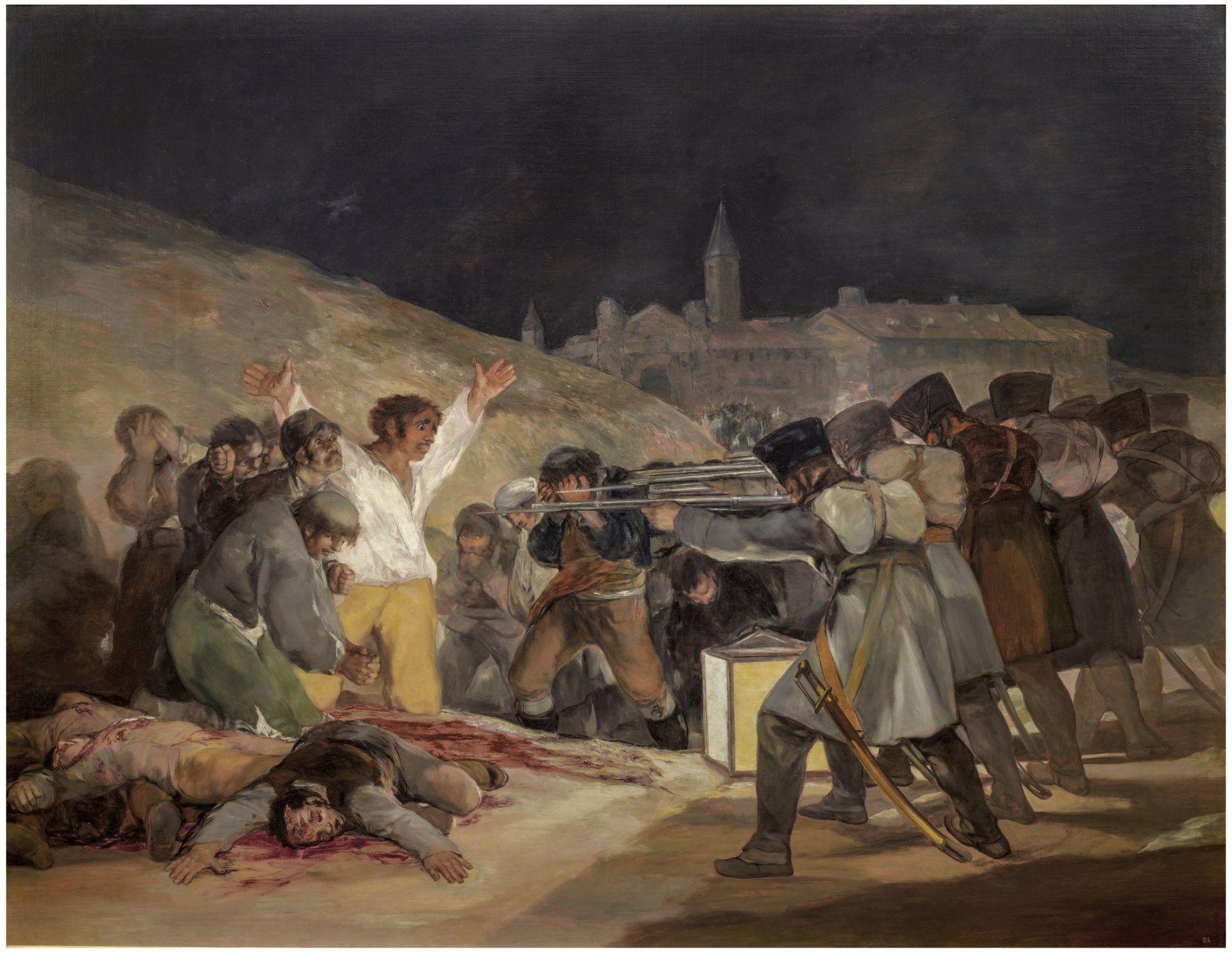
Francisco de Goya, The shooting of the insurgents, ©Museo Nacional del Prado, Madrid
The First World War (1914–1918) is considered the first industrialised mass war in history.
For the first time, war was no longer fought primarily with horses, rifles and cannons, but with the full force of an industrialised society. Factories produced weapons, ammunition, tanks, aeroplanes and poison gas around the clock. As a result, the front was no longer just a place of military conflict, but a gigantic technical apparatus.
Logistics were also industrialised: railways transported troops and supplies on an unprecedented scale, and means of communication such as telegraph and radio made war more predictable – and at the same time more dehumanised. Millions of soldiers became part of a system of machines, steel and trenches.
After the First World War, nothing was the same anymore. Millions of people were dead, entire regions were devastated, states collapsed – and all in the name of progress and reason. People realised that if this ‘civilised’ world was capable of such a war, then something fundamental was wrong.
The idea that technology and reason automatically lead to a better world was shattered. Art and literature reacted radically to this after 1918: Dada, Expressionism, New Objectivity – they all attempted to process this experience of loss of meaning and destruction.
Dada was a direct response to this shock. Artists wanted nothing more to do with the logic that had made war possible. When reason leads to mass murder, all that remains is absurdity.
In Zurich, Berlin and New York, artists such as Hugo Ball, Tristan Tzara and Hannah Höch created collages, sound poems and absurd performances. Dada deliberately destroyed language, form and meaning in protest against a world that had lost its meaning. It was not an escape, but a form of refusal: if everything is absurd, then we will openly show the absurdity.
Expressionism emerged before the war, but the experience of war radicalised it. Expressionist artists wanted to show what was inside, pain, fear, turmoil. Not external reality.
Artists such as Ernst Ludwig Kirchner, Franz Marc and Egon Schiele distorted forms, exaggerated colours and broke with perspective. After 1918, Expressionism became a cry against the old order. The shock was particularly felt in Germany, where artists such as Otto Dix and George Grosz captured the disfigurement and brutalisation of war in unsparing images.
After all the chaos, a counter-movement emerged: New Objectivity. Artists wanted to return to a ‘sober’ and ‘realistic’ depiction of reality – but without idealisation.
Otto Dix, who had served in the war, painted soldiers, cripples, prostitutes and war invalids in the 1920s. No heroism, no hope, just the naked post-war misery. George Grosz caricatured the double standards of a society in which war profiteers and corrupt politicians flourished while others starved.

Josef Scharl, Potato harvest, 1931, Städtische Galerie im Lenbachhaus und Kunstbau München
After the First World War, there was no real peace in Europe, but rather a period of instability and violence. Peace treaties followed (Versailles, 1919, etc.), but they created new tensions instead of lasting peace.
The economic crises of the 1920s and 1930s, the rise of authoritarian and fascist regimes in Germany, Italy, Spain and other countries, and the Spanish Civil War (1936–1939) were all harbingers of the next great war.
With Guernica (cover image), which was shown at the Paris World Exhibition in May 1937, Picasso responded to the bombing of the Basque city of Guernica by the German ‘Legion Condor’ during the Spanish Civil War.
The painting condenses the horrors of modern warfare into an iconic anti-war panorama.
During the Nazi era, art was systematically turned into propaganda. Anything that did not fit into the image of the ‘German national community’ was defamed, banned or destroyed. Art was no longer to be free, but to serve ideology, myth, and the staging of power.
The modern avant-garde movements that flourished during the Weimar Republic were replaced by a style that appeared to be based on ancient and classical ideals. Heroic bodies, rural idylls, depictions of mothers and children, ‘healthy’ landscapes. Men were portrayed as athletic warriors, women as fertile mothers. Symbols of strength, purity, self-sacrifice.
At the same time, works by modern artists such as Paul Klee, Wassily Kandinsky, Franz Marc and Emil Nolde were branded as ‘degenerate’. Many of them were removed from museums, confiscated, destroyed or sold abroad. The 1937 exhibition ‘Degenerate Art’ in Munich was the culmination of this campaign. Millions of people flocked to the exhibition to express their outrage at ‘depraved’ modernism. It was a public display of censorship.
Many artists went into exile in Switzerland, France, the USA or South America. Others fell silent or were forced to adapt. Some, such as Käthe Kollwitz, remained, continued to work quietly and recorded the suffering of the population without currying favour with the regime.
After the end of the Second World War, art – like the world – lay in ruins. And the question arose: how can art still be created after Auschwitz, after Hiroshima, after everything that has happened?
Many artists felt that language and traditional forms of expression had been exhausted. What had been revealed in the world wars – the unleashing of technology, dehumanisation, the silence of so many – made it impossible to trust in old values. Art thus became a testing ground for new forms of expression.
In the USA, Abstract Expressionism developed with artists such as Jackson Pollock, Mark Rothko and Barnett Newman. They believed that only a completely new, non-representational language could do justice to the experience of the 20th century. Pollock's gestural painting, the rhythmic dripping, flinging and pouring of paint, was no longer representation, but action: a physical, almost existential act. Art became a kind of trace of human existence itself.
In Europe, especially in Germany, dealing with the past was much more difficult. After National Socialism, it was not just a question of making a new start, but also of guilt, memory and responsibility. Artists such as Joseph Beuys attempted to create something out of this wound that could enable healing or transformation, using materials such as fat, felt or wax, which symbolise warmth, protection, but also vulnerability. In his actions, Beuys understood art as a social process, as an attempt to change consciousness.
A generation later, Anselm Kiefer took up this debate again. His large-format, heavy paintings, featuring earth, straw, ash and lead, are reminiscent of burnt landscapes, ruins and myths. They raise the question of how memory can be materialised. In his work, German history is literally inscribed on the surface.
At the same time, art emerged that was linked to the political movements of the post-war period. In the 1960s and 1970s, art became political and physical: the civil rights movement in the USA, feminism, the anti-war and environmental movements found expression in performance, photography, text and conceptual art. Artists such as Judy Chicago and Martha Rosler used art as a means of visibility, as a language for those who had previously been overlooked or oppressed.
Artistic remembrance took the form of memorials, installations and later photographic works that attempted to capture the unspeakable – the Holocaust, displacement, loss – without aestheticising it. Artists such as Christian Boltanski, Gerhard Richter and many followers of Käthe Kollwitz sought to make silence, absence and gaps visible.

Kazuo Shiraga, Golden Wings Brushing the Clouds Incarnated from Earthly Wide Star (Chikatsusei Maunkinshi), 1960, The Art Institute of Chicago
After the end of the Cold War, i.e. from the 1990s onwards, the major political fronts shifted. The world was suddenly open. Borders fell, communication became global, and the internet created a new public sphere. Art responded to this by focusing less on form or style and more on position, perspective and context.
The focus of many artists shifted to questions of identity, belonging, gender roles and perspective. Who is allowed to tell stories? Whose stories are shown? And what happens when you reverse the perspective?
Art became a medium for feminist and queer self-assertion. Works by Cindy Sherman, Zanele Muholi, Tracey Emin and Mona Hatoum, for example, explore identity through the body, vulnerability and self-presentation.
Postcolonial voices became more visible, for example in the work of Yinka Shonibare, El Anatsui, Kara Walker and Shirin Neshat, who deal with power relations, migration and cultural memory. And with the advent of social media, the self became increasingly virtual. Artists such as Amalia Ulman and Hito Steyerl began to address precisely this blurring of the real and digital self.

Shirin Neshat Exhibition, 2015, Hirshhorn Museum and Sculpture Garden
Since around 2010, art has once again become more socially and ecologically political. The climate crisis has become a global symbol of a new sense of vulnerability. Many artists are addressing the question of how much intervention the earth can withstand.
In doing so, they are not simply showing the destruction of nature, but the relationship between humans and the planet. It is about traces, materiality, and responsibility.
After the financial crisis of 2008, social inequality became one of the most discussed topics in the art world. Artists show precarious living conditions, exploitation, and economic power relations. At the same time, they reflect on the fact that the art world itself is part of this inequality. Who can afford art? Who is shown, who is overlooked?
Artists address migration, flight, and uprooting in their works. Not as a political issue, but as an existential one. What does home mean when it is not safe? How can one talk about loss without exploiting it?
Today, art is also an arena for social tensions – populism, nationalism, and extremism. The digital public sphere has radically changed the relationship between truth and image.
Artists are responding to the loss of shared realities, to fake news, social media filter bubbles and the manipulative use of images.
Contemporary art is attempting to create new forms of testimony, solidarity, and memory.
Contemporary art is decentralised, global, networked, but at the same time deeply personal. Despite the many voices of today's crises, at its core it is about the loss of trust and belonging. And so the exploration of identity remains crucial in art – now as part of these crises.
It asks: How is identity changing in a world that is simultaneously networked and divided?
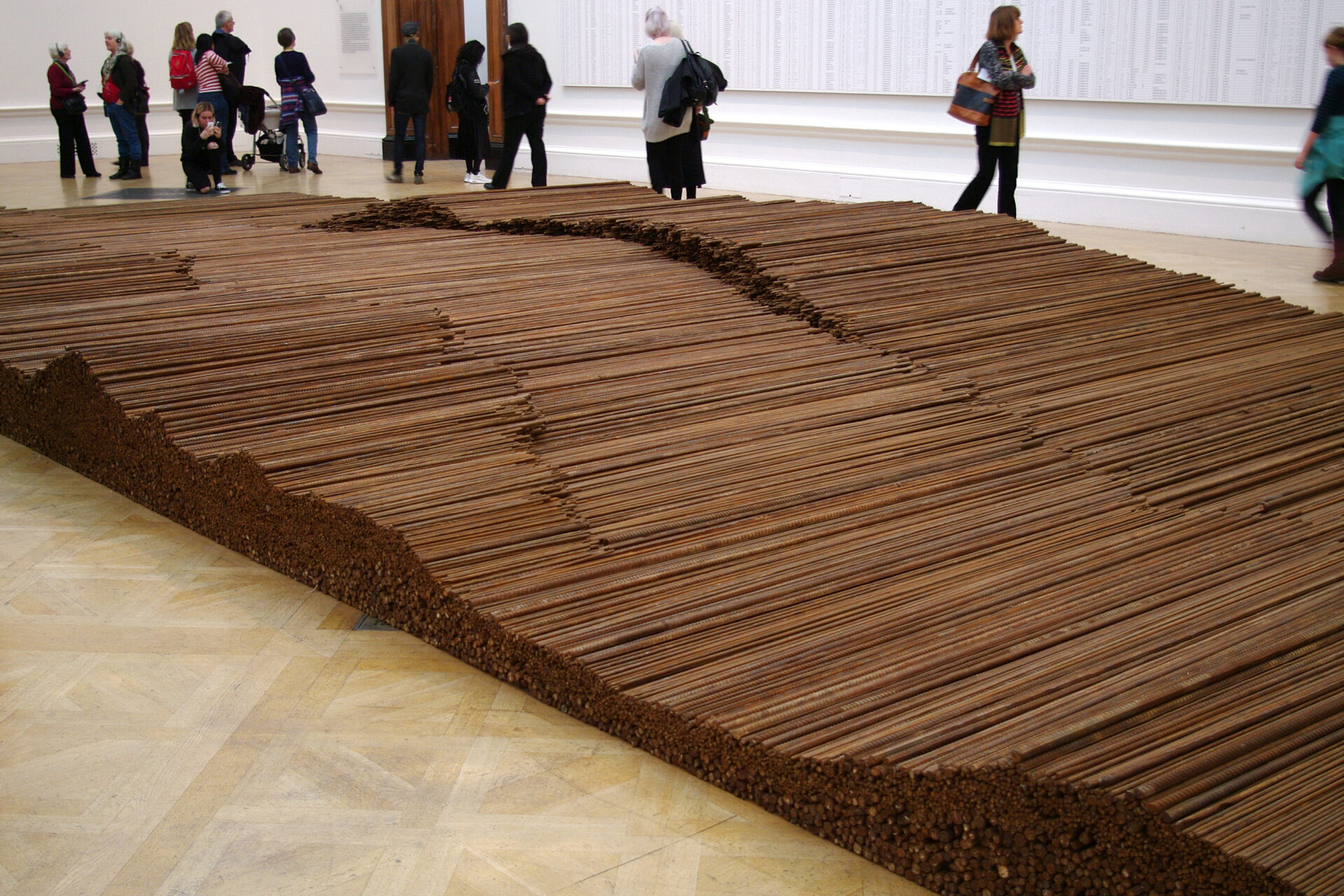
Ai Weiwei, Straight, 2008-2012
Join the newsletter now
and not miss a thing
Get exclusive insights into my creative processes, learn the stories behind my artwork
and receive invitations to my exhibitions and events.
To say thank you, I'll give you 10% off your first purchase.